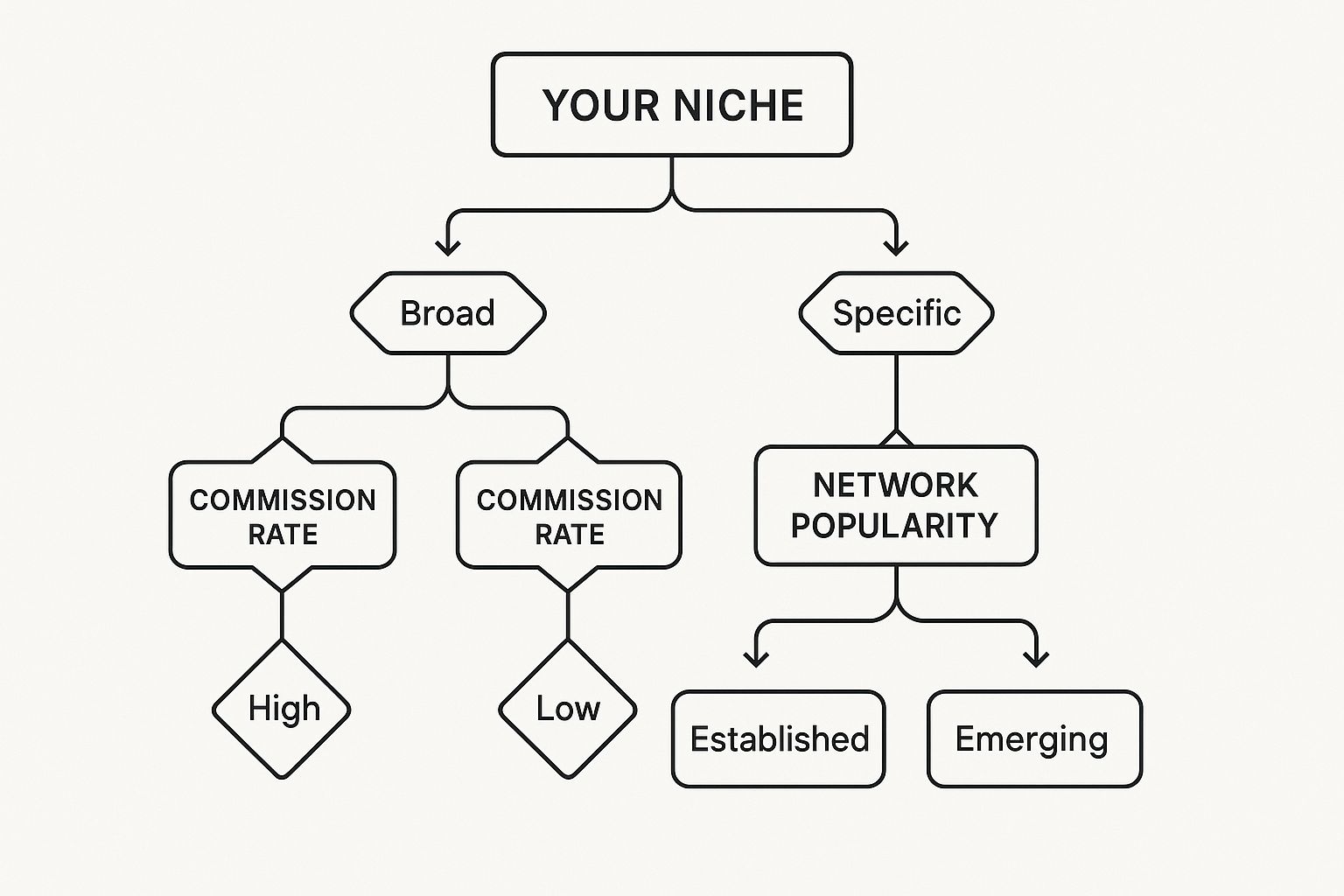So, you're thinking about diving into affiliate marketing? Let's get one thing straight right away: this isn't about being a pushy salesperson. At its heart, affiliate marketing is a business model where you earn a commission by recommending products you genuinely believe in. Think of yourself as a trusted guide, helping your audience find solutions to their problems.
Your First Steps into Affiliate Marketing

Affiliate marketing has grown far beyond a simple side hustle. It's a legitimate and powerful business strategy that bridges the gap between brands and customers using trusted voices—like yours. The concept is straightforward: you promote a product or service with a unique affiliate link, and when someone clicks it to make a purchase, you get paid a commission.
It’s a performance-based model, which makes it a win-win. Merchants gain new customers through cost-effective marketing, and you get to monetize your content and influence.
The industry's growth is pretty staggering, which really speaks to how effective it is. The global affiliate marketing space is currently valued at around $18.5 billion and is on track to hit over $31.7 billion by 2031. This boom is fueled by the rise of e-commerce and the fact that more than 80% of advertisers now run affiliate programs to acquire customers.
The Key Players in the Ecosystem
To really get how this all works, you need to understand the four main players who make the wheels turn:
- The Merchant: This is the company that actually creates and sells the product. It could be a giant like Amazon or a specialized SaaS company like Refgrow. They're the ones setting the commission rates and giving you the affiliate links.
- The Affiliate (That's You): As the publisher or content creator, you promote the merchant's products. You might be a blogger, a YouTuber, a social media influencer, or anyone with an audience that trusts you.
- The Customer: This is the person who sees your promotion, clicks your link, and ultimately buys the product. They are the engine that drives the entire process.
- The Affiliate Network (Optional): Think of these as the middlemen connecting merchants and affiliates. Platforms like ShareASale or CJ Affiliate host offers from thousands of merchants, take care of tracking, and handle payments, making life easier for everyone.
The most successful affiliates I've seen don't just chase the highest commissions. They build deep trust by promoting products they actually use and that solve a real problem for their audience. In this game, authenticity is your most valuable currency.
Building Your Foundation
To get started, you need more than just a random collection of links. You're building a business, and that means you need a solid foundation. This starts with picking a specific area of interest—your niche—and then building a platform to share your knowledge and recommendations.
Your platform might be a blog, a YouTube channel, or even a highly focused social media account. The crucial part is creating genuinely valuable content that attracts and helps your ideal audience. For more hands-on advice, you can check out our guide on affiliate marketing tips for beginners. This is where you'll build the authority that makes your recommendations not just credible, but truly effective.
To kick things off, you need to get a few core elements in place. This table breaks down the essentials for starting your affiliate business journey.
Core Components of Your Affiliate Business
| Component | Description | First Action Step |
|---|---|---|
| Niche | Your specific area of focus or expertise (e.g., sustainable home goods, video editing software). | Brainstorm 5-10 topics you're passionate and knowledgeable about. |
| Platform | The place where you will publish content (e.g., blog, YouTube channel, Instagram). | Choose one primary platform to start with based on your niche and strengths. |
| Content | The valuable information you create to attract and help your audience. | Outline your first 3-5 pieces of content that address a common problem in your niche. |
| Audience | The group of people who trust your recommendations and follow your content. | Define your ideal audience member: their interests, problems, and where they hang out online. |
Getting these pieces right from the start will set you up for long-term success, turning your affiliate marketing efforts from a hobby into a real, sustainable business.
Finding Your Niche and Audience

Let's be blunt: picking your niche is the single most important decision you'll make in affiliate marketing. It’s the foundation for everything that follows—your content, your audience, and, yes, your income. Don't just chase what's trendy. The real sweet spot is where your genuine interests overlap with actual market demand.
Your passion is what keeps you going. Trust me, if you pick a niche like "vintage fountain pens" just because it sounds cool but you couldn’t care less about them, you'll burn out fast. You won’t want to write the articles or make the videos. So, start by brainstorming topics you actually enjoy talking about. That authenticity is magnetic; it’s what builds a loyal community that hangs on your every word and trusts your recommendations.
From Passion to Profitability
Got a list of interests? Great. Now it's time to see if they can actually make you money. A passion for something doesn't automatically translate into a profitable niche. You need to confirm that people are actively looking for solutions and information in that area.
A quick and dirty way to do this is with Google's autocomplete. Just start typing your topic into the search bar and watch what pops up. These are real questions from real people. For instance, if you're into "home coffee brewing," you’ll likely see suggestions like:
- Best espresso machine for beginners
- How to make cold brew at home
- Pour-over vs. French press coffee
Each of those phrases represents a specific problem or a desire to buy something. That's your opening. It’s where you can create genuinely helpful content and naturally weave in affiliate links. This simple check takes you from a broad idea to a handful of specific, monetizable sub-niches.
The best niches solve a specific problem for a specific group of people. Instead of "fitness," zero in on "kettlebell workouts for busy parents." Don't just talk about "travel"; focus on "budget-friendly solo travel in Southeast Asia." Getting specific is how you attract a dedicated audience that's ready to take your advice.
Putting Your Niche Idea to the Test
Now we need to dig a bit deeper. You need to be sure there’s enough demand and a clear path to earning commissions. A great niche has an audience that's not just looking for freebies—they're willing to spend money on products that will make their lives easier.
It's no secret that evergreen niches like education, travel, or beauty have high consumer interest. And with approximately 81% of brands now running affiliate programs, you won't be short on potential partners.
A huge part of this validation process is finding products you can actually stand behind. If you're looking at the software world, for example, there are countless products to promote. Our guide on SaaS affiliate marketing breaks down exactly how to find and promote these high-ticket items.
Finally, you have to size up the competition. Search for your main keywords. Who's on page one of Google? Is it dominated by huge media companies, or is it mostly individual bloggers? A healthy mix is a good sign. If it’s all corporate giants, you might have a tough climb. But if it's a bunch of small, low-quality sites, that's your chance to come in with superior content and take over. A good balance signals a profitable niche just waiting for a new voice of authority—yours.
7. Finding Affiliates and Onboarding Them Effectively
Now that you’ve built a solid foundation for your affiliate program, it’s time to find the right partners to help promote your product. This isn't just a numbers game; it's about finding people whose audience and values align with your brand. The quality of your affiliates will directly impact the success of your program.
You’ll face a fundamental choice right away: do you partner with companies through their in-house programs, or do you join a large affiliate network?
Working directly with a company often means higher commissions and a closer relationship with the brand. On the other hand, networks like ShareASale, CJ Affiliate, or Impact are massive marketplaces. They offer access to thousands of merchants from one central hub, which is great for variety but might mean slightly lower commission rates.
Look Beyond the Commission Percentage
A flashy commission rate is easy to get excited about, but it's just one part of the equation. Honestly, a 20% commission on a product that doesn't sell is worth nothing. I’d much rather have a 5% commission on something my audience genuinely needs and is excited to buy. That's where the real money is.
The most profitable partnerships are built on alignment, not just big numbers. Focus on promoting products that are a natural fit for your audience's needs and that you can recommend with total confidence. Trust is your greatest asset.
So, what should you actually look for? I have a mental checklist I run through every time I consider a new partnership.
- Cookie Duration: How long do you get credit for a sale after someone clicks your link? A longer window, like 60-90 days, is always better than a short one, like 24 hours. It gives your audience time to make a decision.
- Payment Reliability: You need to know you'll get paid on time, every time. Look into the program's history, payment thresholds, and available methods to make sure it all works for you.
- Product Quality: This one is non-negotiable. Never, ever promote a product you wouldn’t use yourself. Your reputation is on the line with every single recommendation you make. Pushing a shoddy product will destroy the trust you've worked so hard to build.
This decision tree can help you visualize which path makes the most sense for your specific situation.

As you can see, the best approach really depends on whether your niche is broad or highly specific, and what you prioritize—be it higher commissions or the support of a large network.
Create Your Own Partner Vetting Checklist
To stay organized, I recommend creating a simple, repeatable checklist. Before you even think about signing up, run the program through your criteria to make sure it’s a good fit for your brand and offers a truly fair partnership.
Thinking about this from the other side can be incredibly helpful, too. If you're a business owner, understanding how to find affiliates gives you powerful insight into what makes a program attractive to high-quality partners.
Ultimately, choosing the right programs boils down to good research and authenticity. When you partner with brands that provide real value, your audience will reward you—not just with their clicks, but with their trust.
Creating Content That Connects and Converts

Let's talk about content. Your content is the bridge between your audience's problems and the solutions you're recommending. If that bridge feels flimsy or untrustworthy, no one is going to walk across. To really get traction in affiliate marketing, you have to move beyond generic blog posts and create content that forges a real connection.
Think of yourself not as a salesperson, but as the most helpful guide on the internet for your niche. When you solve a genuine problem for your reader, the conversion is just the logical next step—not some forced, awkward pitch. This builds long-term trust, which is infinitely more valuable than a one-off commission.
High-Impact Content Formats
Not all content is created equal. I've found that a few key formats consistently deliver the best results. Each one serves a slightly different purpose, but they all share one common goal: to provide overwhelming value to the reader.
Detailed Product Reviews: This is your chance to go deep. Don't just list features from the product's website. Share a personal story. For example, instead of a generic review of a project management tool, document exactly how you used it to wrangle a chaotic product launch into submission. Show screenshots, share the real results, and turn a simple review into a compelling case study.
Head-to-Head Comparisons: Your audience is almost always stuck between a few popular options. Do the heavy lifting for them. A "Product A vs. Product B" post should be ruthlessly honest. Talk about where each product shines and, just as importantly, where it falls short. This balanced perspective makes your final recommendation far more credible and trustworthy.
Step-by-Step Tutorials: These are pure gold. Nothing builds authority faster than teaching someone how to do something valuable. Create a tutorial that helps your audience get a specific win using the product you’re promoting. A guide on "How to Set Up Your First Automated Webinar Using [Software Name]" provides immediate utility. Your affiliate link then becomes a helpful resource within the guide, not the entire reason for its existence.
Your content's primary job is to help, not to sell. When you focus on solving your reader's problem, you build authority. The trust that comes from that authority is what ultimately drives conversions and turns affiliate marketing into a sustainable business.
When you're deciding what to create, think about what your audience needs most at that moment. Here’s a quick breakdown to help you match the content type to its best use case.
High-Converting Content Type Comparison
| Content Type | Best For | Conversion Potential |
|---|---|---|
| Product Reviews | Building deep trust and demonstrating a product's real-world value to a single user. | High |
| Comparison Posts | Capturing an audience that is late in the buying cycle and needs help making a final decision. | Very High |
| How-To Guides | Attracting a wider audience by solving a problem and showcasing the product as part of the solution. | Medium to High |
Each format has its place, and a well-rounded affiliate strategy often includes a mix of all three to meet readers at different stages of their journey.
Weaving in Links and Calls-to-Action
How you place your affiliate links is just as important as the content itself. Let's be real: your readers know what an affiliate link is. Transparency is your best friend here. A simple, friendly disclosure—something like "(heads up: this is an affiliate link, which means I may earn a commission at no extra cost to you!)"—goes a long way in building trust.
Place your links where they feel natural. Don't force them into every other sentence; that just feels spammy. Instead, add them when you first mention a product or inside a summary box where you recap your recommendation.
Your call-to-action (CTA) should guide, not shove. Ditch the generic "Buy Now" for something that feels more specific and value-driven.
Try these on for size:
- "Check out the latest pricing for [Product Name] here."
- "See how [Product Name] can streamline your workflow."
- "Start your free trial of [Product Name] and test it yourself."
These are invitations, not demands. This subtle shift in language keeps the helpful tone of your content intact while still encouraging your reader to take the next step.
Remember, where you publish matters, too. Over 27% of brands use blogs for promotion, but more than 75% of marketers are active on Facebook. And with mobile devices driving more than half of all affiliate-driven traffic, a mobile-friendly site isn't a luxury—it's essential. You can dive deeper into these trends by reading these insightful affiliate marketing statistics.
Driving Traffic to Your Affiliate Content
So, you've created some fantastic, genuinely helpful content. That's a huge step, but it's only half the journey. If nobody sees it, it can't build trust, let alone earn you commissions. Now, it's time to shift gears and focus on bringing a consistent stream of interested people to your digital doorstep.
We're not talking about chasing fleeting viral moments or just throwing money at ads and crossing your fingers. The affiliate businesses that stand the test of time are built on a solid foundation of organic traffic. That means getting comfortable with Search Engine Optimization (SEO). When someone Googles a problem you solve, you need to be the answer they find.
Mastering Foundational SEO
SEO can sound like a complex, technical beast, but at its heart, the idea is refreshingly simple: create the absolute best, most helpful resource on a specific topic. It all begins with figuring out what your audience is actually typing into that search bar.
- Dig for Keywords: Use keyword research tools to uncover the exact phrases people are using. Zero in on "solution keywords" like "how to connect laptop to TV" or "why is my website slow." These are queries where a product recommendation feels like a natural, helpful part of the solution.
- Go Deep with Your Content: Don't just scratch the surface. Aim to create a comprehensive piece of content that thoroughly solves the user's problem from start to finish. This is a massive signal to Google that your page is a high-value resource worthy of a top ranking.
- Fine-Tune Your Post: Weave your main keyword into the title, the opening paragraph, and a few other natural spots in the text. Most importantly, make sure your page is a breeze to use and loads quickly.
I see so many new affiliates make the same mistake: they focus only on the money. You can't make sales until you get traffic. Your very first goal should be attracting a steady flow of visitors by being genuinely useful. The income is a byproduct of that trust.
SEO is definitely a long game, but the payoff is unmatched. Every well-optimized article becomes a digital asset, capable of bringing in targeted traffic for years to come.
Your Most Valuable Asset: An Email List
While SEO is fantastic for bringing new people into your world, an email list is how you build a lasting relationship with them. Think of it as the one communication channel you truly own, completely immune to the whims of Google's algorithms or social media platform changes. Building your list should be a top priority from day one.
Start by offering a valuable "lead magnet"—something compelling in exchange for an email address. This could be a simple checklist, a detailed resource guide, or even a free mini-course. This gives you a direct line to your most engaged followers, allowing you to build deeper trust and share your best recommendations with an audience that's eager to listen.
Smart Social Media and Paid Ads
Social media can be another powerful lever for traffic, but don't fall into the trap of trying to be everywhere at once. Pinpoint the one or two platforms where your target audience actually hangs out and dedicate your energy there. Share bite-sized tips, jump into relevant conversations, and consistently point people back to your long-form content.
Once you have some momentum, paid advertising can be a great way to pour fuel on the fire. To get the most bang for your buck, a deep dive into competitor ad analysis can reveal exactly what’s working for others in your niche. Learning from their successes—and their mistakes—can make your own ad spend far more effective right from the start.
Got Questions? We’ve Got Answers
Stepping into the world of affiliate marketing for the first time can feel like learning a new language. You’re bound to have questions. Let's walk through some of the most common ones I hear from people just starting out, so you can move forward with confidence.
What Kind of Money Are We Talking About?
Ah, the million-dollar question. The honest-to-goodness answer? It's all over the map. When you first dip your toes in, you should expect to make next to nothing for the first few months. Seriously. Your energy should be poured into creating genuinely helpful content and getting eyeballs on it, not refreshing your earnings dashboard.
If you stick with it consistently, pulling in a few hundred dollars a month within your first year is a realistic goal. Of course, you see the superstars making six or even seven figures a year, but that doesn't happen overnight. That level of success is the result of years of grinding, building deep expertise, and cultivating a large, loyal audience that trusts them implicitly.
My Two Cents: Forget about the money in the beginning. Focus on one thing: delivering real value. When you build trust and become a go-to resource, the income follows. It's a byproduct of doing good work, not the goal itself.
Is a Website an Absolute Must?
Having your own website or blog is the gold standard, no doubt. It's your digital real estate—an asset you own and control completely for the long haul. But is it the only way to start? Absolutely not.
You can definitely get the ball rolling on other platforms where you already have an audience.
- Social Media: Got a following on YouTube, Instagram, or Pinterest? These are fantastic places to start, especially if your niche is visual.
- Email Newsletters: An email list is pure gold. It's a direct connection to your most dedicated followers, an asset you truly own.
That said, a website gives you total control. You're not at the mercy of some algorithm change or a platform's shifting rules. For building a serious, sustainable business, it's the most reliable foundation you can have.
What are the Biggest Rookie Mistakes to Avoid?
I've seen so many enthusiastic beginners trip over the same hurdles. If you can sidestep these common mistakes, you’ll be way ahead of the curve.
- Picking a Niche You Don't Care About: If you’re not genuinely interested in the topic, creating content will feel like a chore, and you’ll burn out fast.
- Promoting Everything Under the Sun: Your product recommendations need to make sense together. They should solve a clear set of problems for a specific person.
- Selling Instead of Serving: Your job is to be a trusted guide, not a pushy salesperson. A hard sell is the quickest way to demolish the trust you’ve worked to build.
- Quitting Before the Magic Happens: Affiliate marketing is a marathon, not a sprint. It takes time and patience to gain traction. Don’t give up.
What’s the Real Cost to Get Started?
You can actually get going on a shoestring budget. Your biggest investment won't be money; it'll be your time. The hours spent learning, writing, recording, and connecting with your audience are where the real work lies.
Financially, you can lock down a domain name and basic web hosting for as little as $50 to $100 for an entire year. Many of the best tools for things like keyword research and email marketing have free plans that are perfectly capable when you're starting out. You don’t need to drop thousands to get in the game.
Ready to launch and manage your own affiliate program without the usual friction? Refgrow makes it simple for SaaS businesses to embed a fully native referral dashboard into their product with just one line of code. Connect with our network of affiliates and start scaling your growth today. Learn more and get started with Refgrow.

